Tieniu Tan
Reinforcing Spatial Reasoning in Vision-Language Models with Interwoven Thinking and Visual Drawing
Jun 11, 2025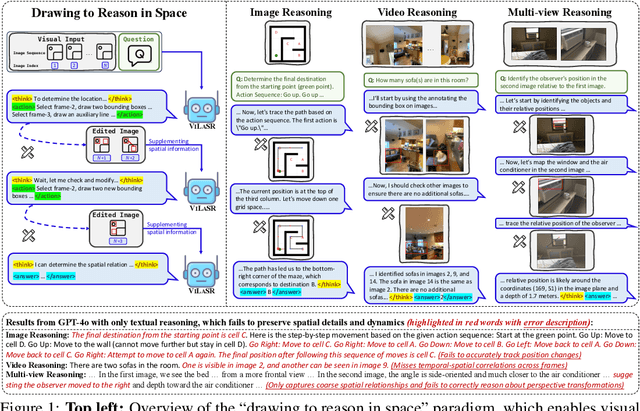
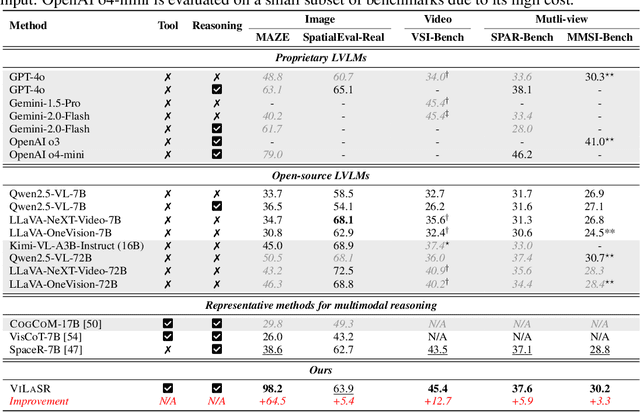


Abstract:As textual reasoning with large language models (LLMs) has advanced significantly, there has been growing interest in enhancing the multimodal reasoning capabilities of large vision-language models (LVLMs). However, existing methods primarily approach multimodal reasoning in a straightforward, text-centric manner, where both reasoning and answer derivation are conducted purely through text, with the only difference being the presence of multimodal input. As a result, these methods often encounter fundamental limitations in spatial reasoning tasks that demand precise geometric understanding and continuous spatial tracking-capabilities that humans achieve through mental visualization and manipulation. To address the limitations, we propose drawing to reason in space, a novel paradigm that enables LVLMs to reason through elementary drawing operations in the visual space. By equipping models with basic drawing operations, including annotating bounding boxes and drawing auxiliary lines, we empower them to express and analyze spatial relationships through direct visual manipulation, meanwhile avoiding the performance ceiling imposed by specialized perception tools in previous tool-integrated reasoning approaches. To cultivate this capability, we develop a three-stage training framework: cold-start training with synthetic data to establish basic drawing abilities, reflective rejection sampling to enhance self-reflection behaviors, and reinforcement learning to directly optimize for target rewards. Extensive experiments demonstrate that our model, named VILASR, consistently outperforms existing methods across diverse spatial reasoning benchmarks, involving maze navigation, static spatial reasoning, video-based reasoning, and multi-view-based reasoning tasks, with an average improvement of 18.4%.
VersaVid-R1: A Versatile Video Understanding and Reasoning Model from Question Answering to Captioning Tasks
Jun 10, 2025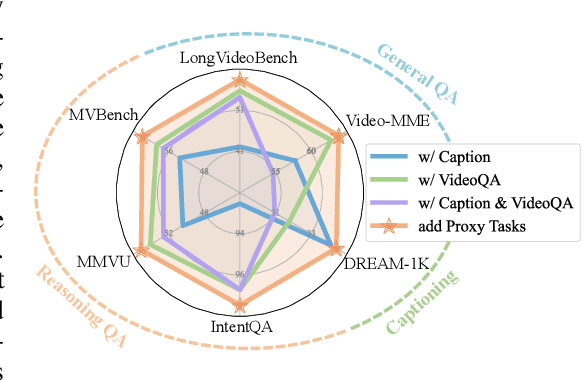

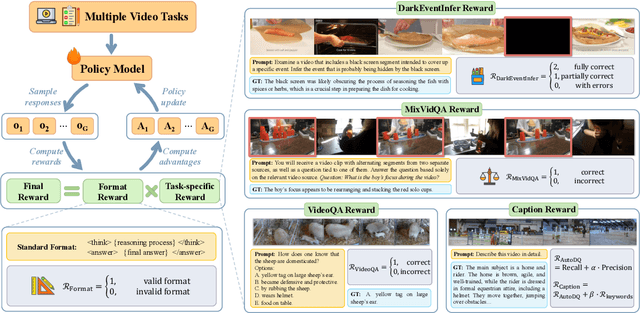

Abstract:Recent advancements in multimodal large language models have successfully extended the Reason-Then-Respond paradigm to image-based reasoning, yet video-based reasoning remains an underdeveloped frontier, primarily due to the scarcity of high-quality reasoning-oriented data and effective training methodologies. To bridge this gap, we introduce DarkEventInfer and MixVidQA, two novel datasets specifically designed to stimulate the model's advanced video understanding and reasoning abilities. DarkEventinfer presents videos with masked event segments, requiring models to infer the obscured content based on contextual video cues. MixVidQA, on the other hand, presents interleaved video sequences composed of two distinct clips, challenging models to isolate and reason about one while disregarding the other. Leveraging these carefully curated training samples together with reinforcement learning guided by diverse reward functions, we develop VersaVid-R1, the first versatile video understanding and reasoning model under the Reason-Then-Respond paradigm capable of handling multiple-choice and open-ended question answering, as well as video captioning tasks. Extensive experiments demonstrate that VersaVid-R1 significantly outperforms existing models across a broad spectrum of benchmarks, covering video general understanding, cognitive reasoning, and captioning tasks.
BridgeVLA: Input-Output Alignment for Efficient 3D Manipulation Learning with Vision-Language Models
Jun 09, 2025Abstract:Recently, leveraging pre-trained vision-language models (VLMs) for building vision-language-action (VLA) models has emerged as a promising approach to effective robot manipulation learning. However, only few methods incorporate 3D signals into VLMs for action prediction, and they do not fully leverage the spatial structure inherent in 3D data, leading to low sample efficiency. In this paper, we introduce BridgeVLA, a novel 3D VLA model that (1) projects 3D inputs to multiple 2D images, ensuring input alignment with the VLM backbone, and (2) utilizes 2D heatmaps for action prediction, unifying the input and output spaces within a consistent 2D image space. In addition, we propose a scalable pre-training method that equips the VLM backbone with the capability to predict 2D heatmaps before downstream policy learning. Extensive experiments show the proposed method is able to learn 3D manipulation efficiently and effectively. BridgeVLA outperforms state-of-the-art baseline methods across three simulation benchmarks. In RLBench, it improves the average success rate from 81.4% to 88.2%. In COLOSSEUM, it demonstrates significantly better performance in challenging generalization settings, boosting the average success rate from 56.7% to 64.0%. In GemBench, it surpasses all the comparing baseline methods in terms of average success rate. In real-robot experiments, BridgeVLA outperforms a state-of-the-art baseline method by 32% on average. It generalizes robustly in multiple out-of-distribution settings, including visual disturbances and unseen instructions. Remarkably, it is able to achieve a success rate of 96.8% on 10+ tasks with only 3 trajectories per task, highlighting its extraordinary sample efficiency. Project Website:https://bridgevla.github.io/
REACT: Representation Extraction And Controllable Tuning to Overcome Overfitting in LLM Knowledge Editing
May 25, 2025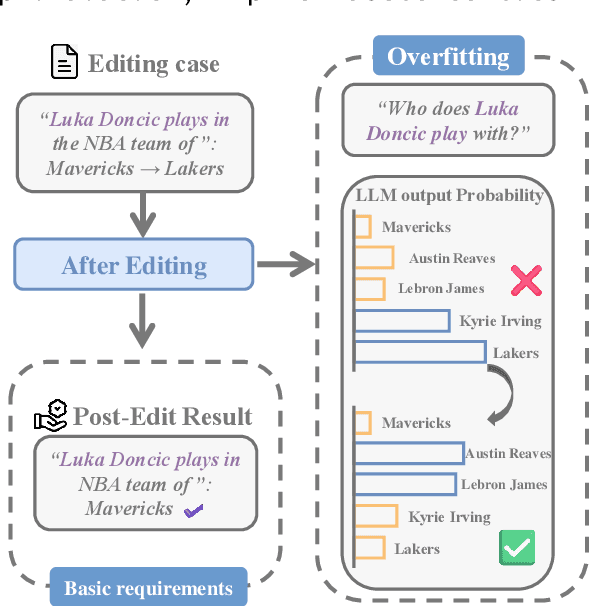
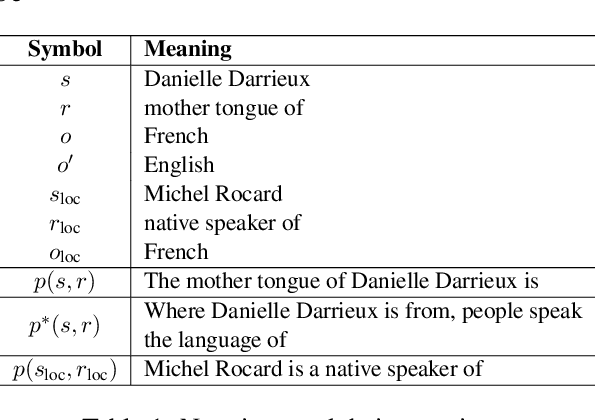
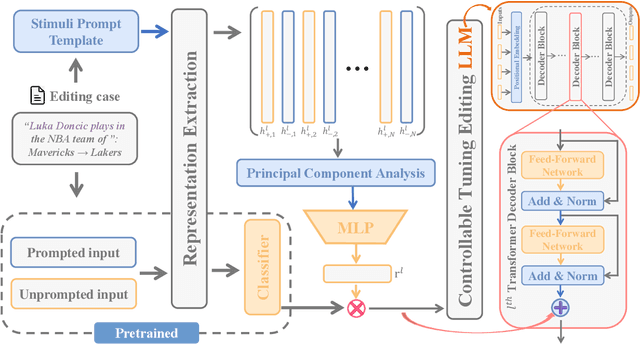
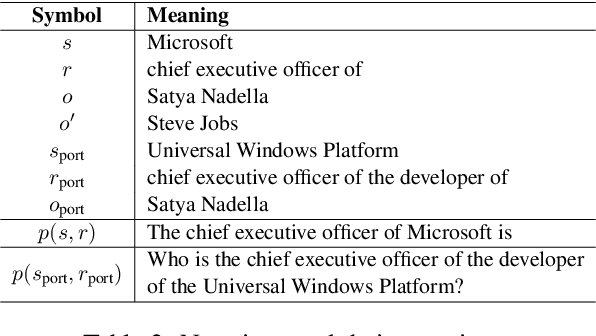
Abstract:Large language model editing methods frequently suffer from overfitting, wherein factual updates can propagate beyond their intended scope, overemphasizing the edited target even when it's contextually inappropriate. To address this challenge, we introduce REACT (Representation Extraction And Controllable Tuning), a unified two-phase framework designed for precise and controllable knowledge editing. In the initial phase, we utilize tailored stimuli to extract latent factual representations and apply Principal Component Analysis with a simple learnbale linear transformation to compute a directional "belief shift" vector for each instance. In the second phase, we apply controllable perturbations to hidden states using the obtained vector with a magnitude scalar, gated by a pre-trained classifier that permits edits only when contextually necessary. Relevant experiments on EVOKE benchmarks demonstrate that REACT significantly reduces overfitting across nearly all evaluation metrics, and experiments on COUNTERFACT and MQuAKE shows that our method preserves balanced basic editing performance (reliability, locality, and generality) under diverse editing scenarios.
Rethinking the Role of Prompting Strategies in LLM Test-Time Scaling: A Perspective of Probability Theory
May 16, 2025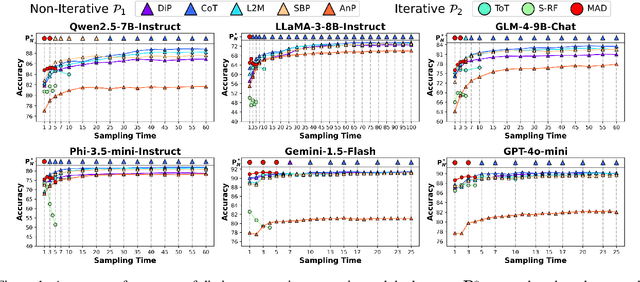

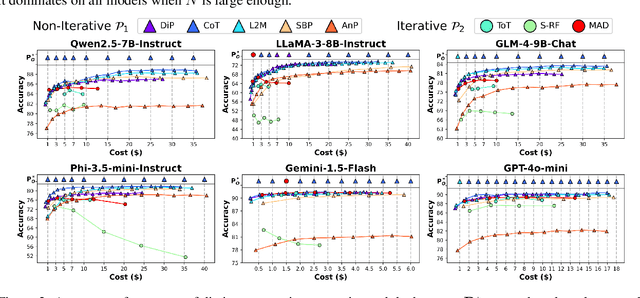

Abstract:Recently, scaling test-time compute on Large Language Models (LLM) has garnered wide attention. However, there has been limited investigation of how various reasoning prompting strategies perform as scaling. In this paper, we focus on a standard and realistic scaling setting: majority voting. We systematically conduct experiments on 6 LLMs $\times$ 8 prompting strategies $\times$ 6 benchmarks. Experiment results consistently show that as the sampling time and computational overhead increase, complicated prompting strategies with superior initial performance gradually fall behind simple Chain-of-Thought. We analyze this phenomenon and provide theoretical proofs. Additionally, we propose a method according to probability theory to quickly and accurately predict the scaling performance and select the best strategy under large sampling times without extra resource-intensive inference in practice. It can serve as the test-time scaling law for majority voting. Furthermore, we introduce two ways derived from our theoretical analysis to significantly improve the scaling performance. We hope that our research can promote to re-examine the role of complicated prompting, unleash the potential of simple prompting strategies, and provide new insights for enhancing test-time scaling performance.
A Call for New Recipes to Enhance Spatial Reasoning in MLLMs
Apr 21, 2025Abstract:Multimodal Large Language Models (MLLMs) have demonstrated impressive performance in general vision-language tasks. However, recent studies have exposed critical limitations in their spatial reasoning capabilities. This deficiency in spatial reasoning significantly constrains MLLMs' ability to interact effectively with the physical world, thereby limiting their broader applications. We argue that spatial reasoning capabilities will not naturally emerge from merely scaling existing architectures and training methodologies. Instead, this challenge demands dedicated attention to fundamental modifications in the current MLLM development approach. In this position paper, we first establish a comprehensive framework for spatial reasoning within the context of MLLMs. We then elaborate on its pivotal role in real-world applications. Through systematic analysis, we examine how individual components of the current methodology-from training data to reasoning mechanisms-influence spatial reasoning capabilities. This examination reveals critical limitations while simultaneously identifying promising avenues for advancement. Our work aims to direct the AI research community's attention toward these crucial yet underexplored aspects. By highlighting these challenges and opportunities, we seek to catalyze progress toward achieving human-like spatial reasoning capabilities in MLLMs.
MME-Unify: A Comprehensive Benchmark for Unified Multimodal Understanding and Generation Models
Apr 07, 2025Abstract:Existing MLLM benchmarks face significant challenges in evaluating Unified MLLMs (U-MLLMs) due to: 1) lack of standardized benchmarks for traditional tasks, leading to inconsistent comparisons; 2) absence of benchmarks for mixed-modality generation, which fails to assess multimodal reasoning capabilities. We present a comprehensive evaluation framework designed to systematically assess U-MLLMs. Our benchmark includes: Standardized Traditional Task Evaluation. We sample from 12 datasets, covering 10 tasks with 30 subtasks, ensuring consistent and fair comparisons across studies." 2. Unified Task Assessment. We introduce five novel tasks testing multimodal reasoning, including image editing, commonsense QA with image generation, and geometric reasoning. 3. Comprehensive Model Benchmarking. We evaluate 12 leading U-MLLMs, such as Janus-Pro, EMU3, VILA-U, and Gemini2-flash, alongside specialized understanding (e.g., Claude-3.5-Sonnet) and generation models (e.g., DALL-E-3). Our findings reveal substantial performance gaps in existing U-MLLMs, highlighting the need for more robust models capable of handling mixed-modality tasks effectively. The code and evaluation data can be found in https://mme-unify.github.io/.
Aligning Multimodal LLM with Human Preference: A Survey
Mar 18, 2025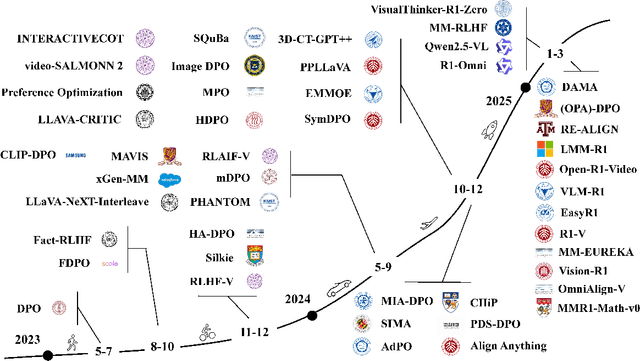
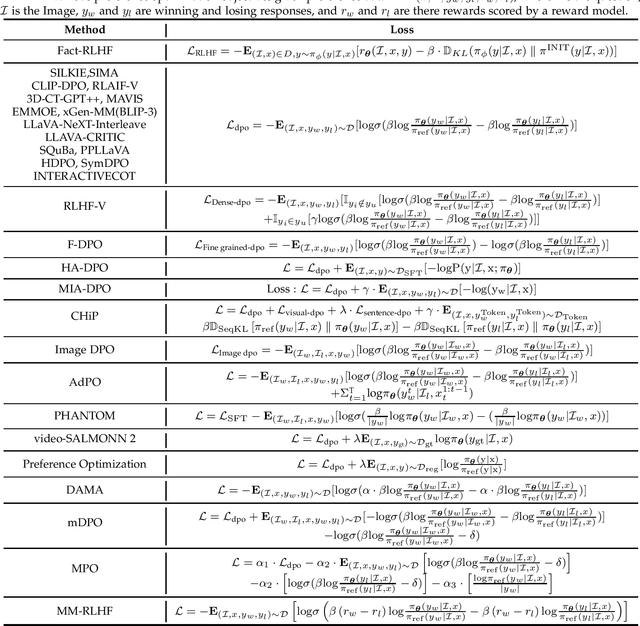
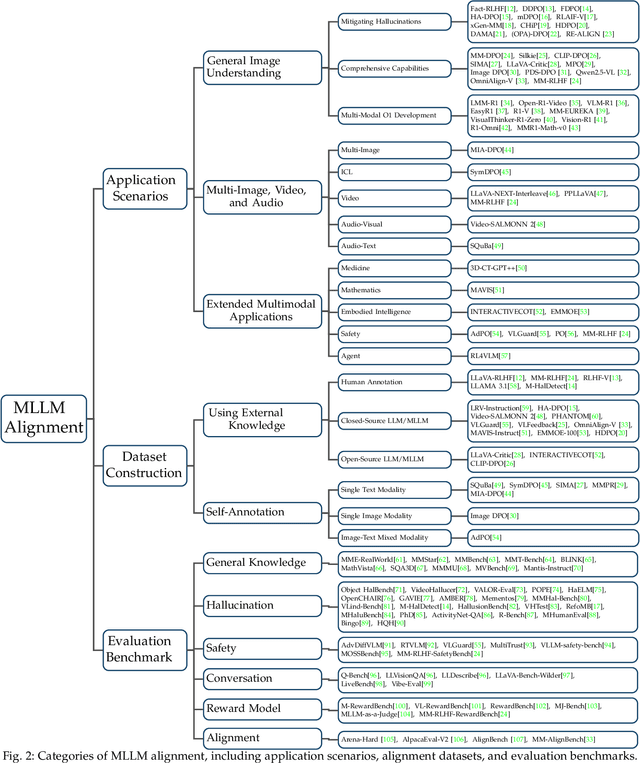
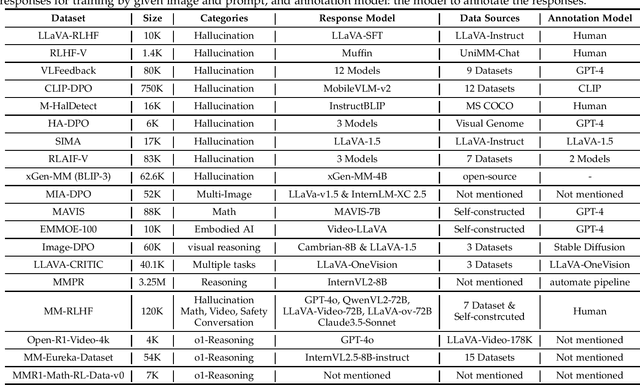
Abstract:Large language models (LLMs) can handle a wide variety of general tasks with simple prompts, without the need for task-specific training. Multimodal Large Language Models (MLLMs), built upon LLMs, have demonstrated impressive potential in tackling complex tasks involving visual, auditory, and textual data. However, critical issues related to truthfulness, safety, o1-like reasoning, and alignment with human preference remain insufficiently addressed. This gap has spurred the emergence of various alignment algorithms, each targeting different application scenarios and optimization goals. Recent studies have shown that alignment algorithms are a powerful approach to resolving the aforementioned challenges. In this paper, we aim to provide a comprehensive and systematic review of alignment algorithms for MLLMs. Specifically, we explore four key aspects: (1) the application scenarios covered by alignment algorithms, including general image understanding, multi-image, video, and audio, and extended multimodal applications; (2) the core factors in constructing alignment datasets, including data sources, model responses, and preference annotations; (3) the benchmarks used to evaluate alignment algorithms; and (4) a discussion of potential future directions for the development of alignment algorithms. This work seeks to help researchers organize current advancements in the field and inspire better alignment methods. The project page of this paper is available at https://github.com/BradyFU/Awesome-Multimodal-Large-Language-Models/tree/Alignment.
VidCapBench: A Comprehensive Benchmark of Video Captioning for Controllable Text-to-Video Generation
Feb 18, 2025Abstract:The training of controllable text-to-video (T2V) models relies heavily on the alignment between videos and captions, yet little existing research connects video caption evaluation with T2V generation assessment. This paper introduces VidCapBench, a video caption evaluation scheme specifically designed for T2V generation, agnostic to any particular caption format. VidCapBench employs a data annotation pipeline, combining expert model labeling and human refinement, to associate each collected video with key information spanning video aesthetics, content, motion, and physical laws. VidCapBench then partitions these key information attributes into automatically assessable and manually assessable subsets, catering to both the rapid evaluation needs of agile development and the accuracy requirements of thorough validation. By evaluating numerous state-of-the-art captioning models, we demonstrate the superior stability and comprehensiveness of VidCapBench compared to existing video captioning evaluation approaches. Verification with off-the-shelf T2V models reveals a significant positive correlation between scores on VidCapBench and the T2V quality evaluation metrics, indicating that VidCapBench can provide valuable guidance for training T2V models. The project is available at https://github.com/VidCapBench/VidCapBench.
Towards Compatible Fine-tuning for Vision-Language Model Updates
Dec 30, 2024



Abstract:So far, efficient fine-tuning has become a popular strategy for enhancing the capabilities of foundation models on downstream tasks by learning plug-and-play modules. However, existing methods overlook a crucial issue: if the underlying foundation model is updated, are these plug-and-play modules still effective? In this paper, we first conduct a detailed analysis of various fine-tuning methods on the CLIP in terms of their compatibility with model updates. The study reveals that many high-performing fine-tuning methods fail to be compatible with the upgraded models. To address this, we propose a novel approach, Class-conditioned Context Optimization (ContCoOp), which integrates learnable prompts with class embeddings using an attention layer before inputting them into the text encoder. Consequently, the prompts can dynamically adapt to the changes in embedding space (due to model updates), ensuring continued effectiveness. Extensive experiments over 15 datasets show that our ContCoOp achieves the highest compatibility over the baseline methods, and exhibits robust out-of-distribution generalization.
 Add to Chrome
Add to Chrome Add to Firefox
Add to Firefox Add to Edge
Add to Edge